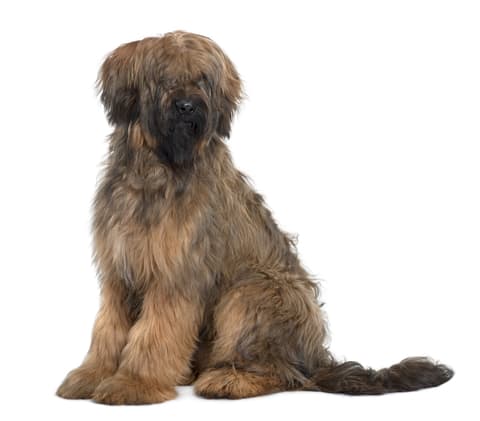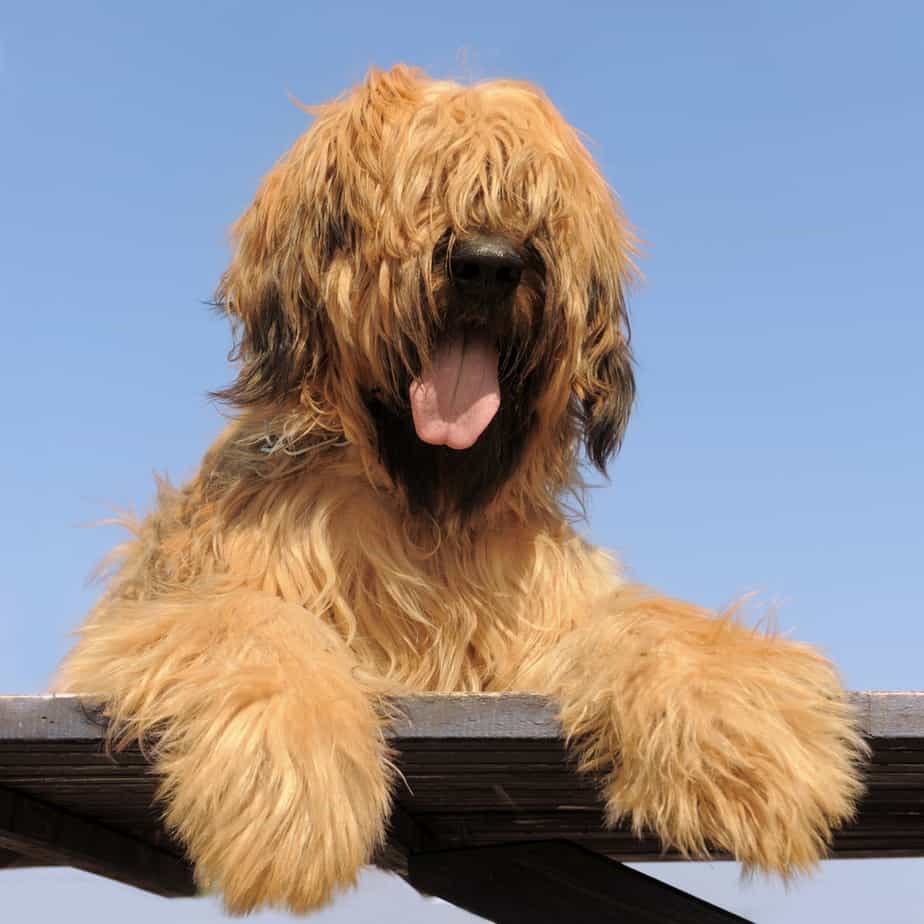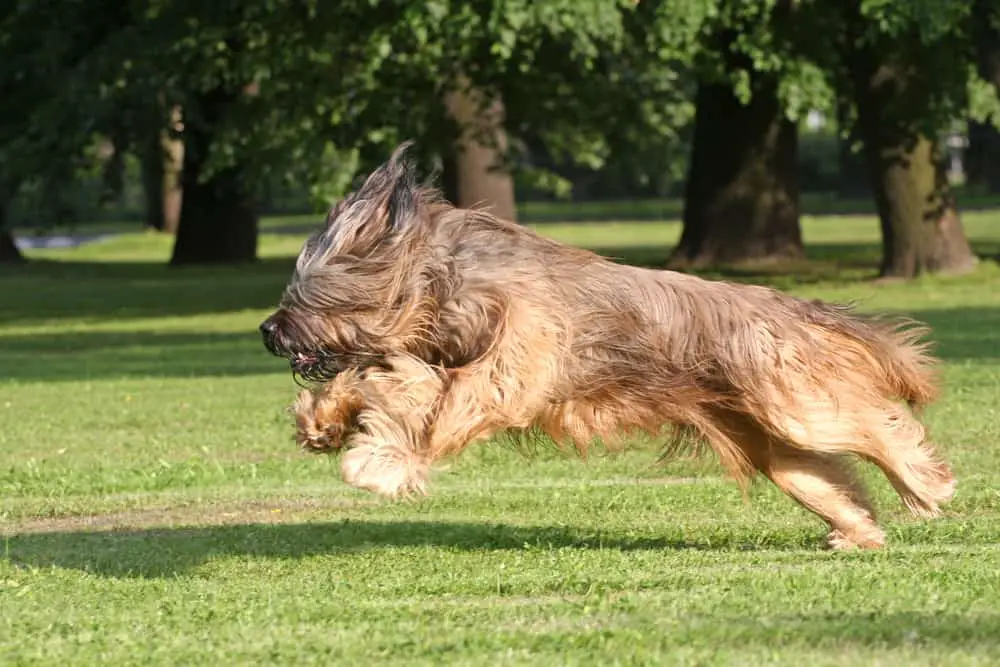Complete Guide To The Briard: Grooming, Health, Personality and More
A gremlin-eared sheepdog with big hair and a heart of gold isn’t the first thing that comes to mind when you think of France, yet the affectionate, multi-talented Briard is one of their finest accomplishments. It’s ooh-la-la at first glance.
Table of Contents
How Big Does A Briard Get?
| Height | Weight | |
| Male | 23″ – 27″ at the shoulder | 70 – 100 lbs |
| Female | 22″ – 25.5″ at the shoulder | 55-75 lbs |

What Does A Briard Look Like?
Enveloped in hair from head to toe, the Briard sports a sophisticated beard and waterfall eyebrows. Locks cascade from their semi-erect ears that stand when they’re intrigued, giving them an instant bouffant.
Their ample coats come in solid black and variable shades of tawny and gray. The texture is so coarse that it makes a dry sound when petted. Eyes are deep brown and secretive behind a soft veil of hair.
Muscular and lean, the Briard’s athletic build is concealed by its coat, but it shows in a light-footed, agile gait. Spirited, they move with grace and confidence.
What Is The Personality Of A Briard?
Briards are ideal for active families who want a constant companion. Tireless, they want to be in the thick of things and make poor kennel dogs. Bred for the outdoors, they need vigorous exercise and may struggle in an apartment but will thrive in homes with room to roam.

Affectionate, they’re wary of strangers and slow to make friends — their trust must be earned. Natural protectors, they’re capable guard dogs and faithful friends for children. Intelligent, independent and fearless, socialization and obedience training are the keys to raising a well-adjusted Briard.
How Much Exercise Does A Briard Need?
Briards are high-energy dogs that love fresh air and sunshine. Bred to herd sheep, they enjoy a good chase and make excellent running or bicycling partners. Plan to work them hard at least an hour a day.
Games that play to their strengths fulfill their exercise needs and keep them mentally stimulated. Top canine athletes, they excel in competitive events from obedience and agility. Happy to work or play, they’re remarkable search-and-rescue dogs — an activity they like because they can do it with their owners.
Activities That I Recommend With This Breed:
- Walking
- Hiking (don’t do this if your dog has any orthopedic issues)
- Agility Training (these guys do great at this!!)
- Dog Parks
How Much Grooming Does A Briard Need?
Grooming is a fact of life for Briard owners. They don’t shed much, but the same billowy coat that gives them their dapper look takes effort to maintain — plan on a two-hour commitment. Twice weekly grooming with a pin brush removes debris — use a stiff metal comb to thin the undercoat and tease out tangles before they become mats.
Bathing requirements depend on their lifestyle. The Briard’s coarse hair is rarely greasy and has little odor, but long hair on their feet and belly attract dirt, so they’ll likely need plenty of tub time. The good news is it won’t harm their skin if you stick to a gentle shampoo — the bad news is that they take a lot longer to dry than to bathe.
Most owners can handle care at home, but professional groomers have the experience and tools to do the job efficiently. A short trim is attractive and lengthens the time between visits. Regular spa days are a great value — they include ear cleaning and a nail trim, leaving only maintenance chores for owners.

What Kind of Dog Food Is Good For A Briard?
Personally I believe that most foods are fine for most dogs. Some dogs may not do well on some foods. However, as a rule I don’t blanket-prohibit any dietary ingredient from any breed at this time.
This is a breed that requires a large-breed puppy food to help control growth. Growing too fast can cause growing pains and potentially developmental orthopedic issues. For this reason, I recommend to my Briard owners to switch to adult food at around 6 months of age.
Best Puppy Food For Briards:
Best Adult Food For Briards:
- Purina Pro Plan Large Breed
- Eukanuba Adult Dry Dog Food
- Nutro Natural Choice Large Breed Adult
- Merrick Classic Healthy Grains Dry Dog Food
Please don’t listen to the folks at the pet store trying to convince you to buy a grain-free diet for your dog. There’s zero science behind that and vets are actually seeing diseases now related to feeding grain-free foods.
It’s very important they remain at their optimal weight throughout their life. Have your vet go over with you exactly where to feel to know when your dog is too big.
How Long Does A Briard Live?
14 years based on information from the AKC – this is pretty old for a large breed dog of its size but if you keep the joints healthy and the overall size at a healthy weight, this is very doable.
What Health Problems Can A Briard Have?
The Briard has one real area of concern: orthopedic issues. Because of their size, their joints bear a lot of stress from a young age. The most common issues I see in my Briard patients include:
- Elbow/Hip Dysplasia
- Arthritis in older age in any joint but especially the elbows, hips, back, and knees
- ACL tears
- Obesity
Due to the risk of joint issues, I recommend starting a Briard on a joint supplement by the age of 4 years old. The best joint supplements should be thought of as prevention and not necessarily treatment. Starting early keeps the joints as healthy as they can be for longer than if you did nothing.
My favorite joint supplements include:
Another great option to help your dog with their joints is the J/D food from Hill’s. Although it is a bit expensive, the amount of joint supplements you are giving your dog can be reduced or eliminated by just feeding this diet. For my clients, it has seemed to work best earlier in life before the joint issues got too severe.
Where Can I Find Out More About The Briard?
Where Can I Find A Briard?
Breeder Listings From the Briard Club of America
Looking to get a Rescue instead? Start with the Briard Rescue Trust
Interesting Facts About the Briard
Briards have an entertaining history.
Did you know?
• They Hail from Brie
The dairy-producing region of Brie, France, home of one of the world’s favorite cheeses, gave rise to the noble Briard. Known there as the Chien Berger de Brie, they’re the region’s second greatest claim to fame.
• They Rubbed Elbows with Kings
Briards are depicted in artwork dating back to the eighth century and the reign of Charlemagne. So ubiquitous were they in the pastures of France by the 1800s, even Napoleon, who was not a dog lover, was a fan of the breed.
• They’re War Heroes
Sending the French Army to war without their beloved Briards was unthinkable. Made the official military dog, they were drafted and served admirably in two world wars performing tasks from search and rescue to pulling carts of medical supplies.
• The French-American Connection
Briards first came to the United States in 1789 with Thomas Jefferson, then-retiring ambassador to France. Impressed by their abilities, he acquired a pregnant female before returning to his Monticello estate in Virginia.
She proved to be a versatile herder, but more so, became the foundress of the breed in America. Bolstered by additional exports sent by Revolutionary War hero Gilbert du Motier, the Marquis de Lafayette, the population grew and gained fans across the country.
• The Dewclaw Controversy
Dewclaws are extra toes some dogs are born with. Rudimentary, they’re not fully formed, and there’s significant controversy about their risks and benefits. Easily damaged, many owners have them removed at birth, but the Briard, born naturally with two on each rear foot, can’t be shown without them.
